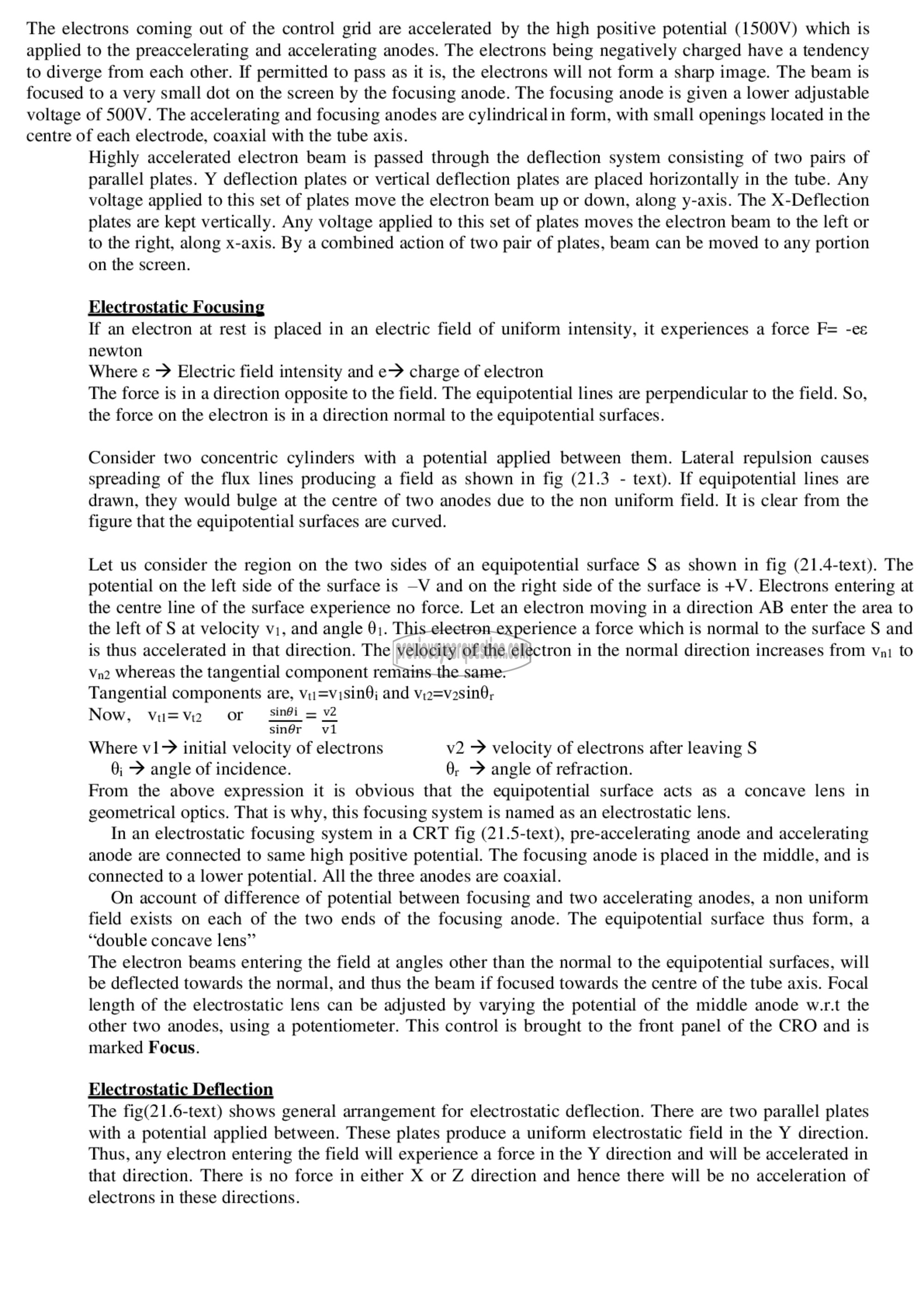APJ ABDUL KALAM TECHNOLOGICAL UNIVERSITY Previous Years Question Paper & Answer
Semester : SEMESTER 4
Subject : Measurements and Instrumentation
Year : 2018
Term : MARCH
Scheme : 2015 Full Time
Course Code : EE 208
Page:24
The electrons coming out of the control grid are accelerated by the high positive potential (1500५) which is
applied to the preaccelerating and accelerating anodes. The electrons being negatively charged have a tendency
to diverge from each other. If permitted to pass as it is, the electrons will not form a sharp image. The beam is
focused to a very small dot on the screen by the focusing anode. The focusing anode is given a lower adjustable
voltage of SOOV. The accelerating and focusing anodes are cylindrical in form, with small openings located in the
centre of each electrode, coaxial with the tube axis.
Highly accelerated electron beam is passed through the deflection system consisting of two pairs of
parallel plates. Y deflection plates or vertical deflection plates are placed horizontally in the tube. Any
voltage applied to this set of plates move the electron beam up or down, along y-axis. The X-Deflection
plates are kept vertically. Any voltage applied to this set of plates moves the electron beam to the left or
to the right, along x-axis. By a combined action of two pair of plates, beam can be moved to any portion
on the screen.
Electrostatic Focusing
If an electron at rest is placed in an electric field of uniform intensity, it experiences a force F= -08
newton
Where ع > Electric field intensity and e> charge of electron
The force is in a direction opposite to the field. The equipotential lines are perpendicular to the field. So,
the force on the electron is in a direction normal to the equipotential surfaces.
Consider two concentric cylinders with a potential applied between them. Lateral repulsion causes
spreading of the flux lines producing a field as shown in fig (21.3 - text). If equipotential lines are
drawn, they would bulge at the centre of two anodes due to the non uniform field. It is clear from the
figure that the equipotential surfaces are curved.
Let us consider the region on the two sides of an equipotential surface S as shown in fig (21.4-text). The
potential on the left side of the surface is —V and on the right side of the surface is +V. Electrons entering at
the centre line of the surface experience no force. Let an electron moving in a direction AB enter the area to
the left of ऽ at velocity vi, and angle 01. This electron experience a force which is normal to the surface ऽ and
is thus accelerated in that direction. The velocity of the electron in the normal direction increases from ४१1 to
Vn2 Whereas the tangential component remains the same.
Tangential components are, ೫/1 ಎ17]51110; and 12-1725120
Now, Vu=V2 or 517601 — v2
sinér जा
Where 112 initial velocity of electrons v2 > velocity of electrons after leaving S
0; > angle of incidence. 0; > angle of refraction.
From the above expression it is obvious that the equipotential surface acts as a concave lens in
geometrical optics. That is why, this focusing system is named as an electrostatic lens.
In an electrostatic focusing system in a CRT fig (21.5-text), pre-accelerating anode and accelerating
anode are connected to same high positive potential. The focusing anode is placed in the middle, and is
connected to a lower potential. All the three anodes are coaxial.
On account of difference of potential between focusing and two accelerating anodes, a non uniform
field exists on each of the two ends of the focusing anode. The equipotential surface thus form, a
“double concave lens”
The electron beams entering the field at angles other than the normal to the equipotential surfaces, will
be deflected towards the normal, and thus the beam if focused towards the centre of the tube axis. Focal
length of the electrostatic lens can be adjusted by varying the potential of the middle anode w.r.t the
other two anodes, using a potentiometer. This control is brought to the front panel of the CRO and is
marked Focus.
Electrostatic Deflection
The fig(21.6-text) shows general arrangement for electrostatic deflection. There are two parallel plates
with a potential applied between. These plates produce a uniform electrostatic field in the Y direction.
Thus, any electron entering the field will experience a force in the Y direction and will be accelerated in
that direction. There is no force in either X or Z direction and hence there will be no acceleration of
electrons in these directions.
